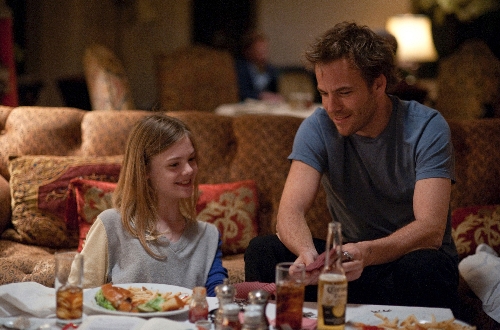‘Somewhere’ overflows with evocative imagery as father, daughter reconnect

Driving around in circles.
When we first meet "Somewhere’s" protagonist, that’s what he’s up to — literally and figuratively.
And in "Somewhere," writer-director Sofia Coppola details the nowhere life of this Nowhere Man with deadpan visual precision, forcing audiences to observe — and make up their own minds about — his self-indulgent existence.
It’s a tough act to pull off, being self-indulgent when you have no sense of self.
Yet if there’s anyone who can capture that sort of contradiction, it’s Coppola.
After all, she won an Oscar for her "Lost in Translation" screenplay, another tale of a movie star, living in a gilded hotel-suite cage, his existential loneliness challenged by a fresh, unjaded female perspective.
In "Lost in Translation," the actor is Bob Harris (played by Bill Murray), the hotel is Tokyo’s Park Hyatt and the female is Charlotte (Scarlett Johansson), a neglected newlywed who becomes Bob’s unlikely Americans-abroad companion.
In "Somewhere," the actor is Johnny Marco (Stephen Dorff). The hotel is Hollywood’s legendary celebrity hideaway the Chateau Marmont. And the young female is Johnny’s 11-year-old daughter Cleo (Elle Fanning).
Johnny doesn’t see Cleo much since he and her mother split.
And while Cleo’s name may be tattooed on his arm, that doesn’t mean she’s on his mind — or in his heart.
Currently between acting assignments, Johnny doesn’t have much to fill his time beyond the occasional publicity junket or preproduction prosthetics session.
Most of the time, he’s behind the wheel of his black Ferrari, vrooming past a world beyond his windshield. Or he’s in his hotel suite, ingesting a seemingly endless succession of cigarettes and beer, hooking up with various semianonymous bed partners and otherwise living the kind of heedless, hedonistic existence most folks associate with Hollywood.
That is, until Cleo’s mom decides to take some time for herself — and dumps Cleo at the Chateau Marmont until further notice.
In most movies, Cleo’s arrival would set the stage for Johnny to discover the joys of fatherhood — and the key to his personal redemption.
Because "Somewhere" is something other than a typical Hollywood heartwarmer, however, Cleo’s arrival — and its impact on her father’s life — trigger more complex developments.
Just don’t expect Coppola to spell them out for you. She’s not that kind of filmmaker — and "Somewhere’s" not that kind of movie.
Unlike most of the pre-digested, connect-the-dots "product" that turns up in theaters these days, "Somewhere" isn’t afraid to explore more shadowy, less predestined territory.
Blessed with a great eye — and a great cinematographer in Harris Savides ("Milk," "Zodiac") — Coppola allows her visuals to speak for themselves.
As a result, "Somewhere" overflows with evocative imagery.
Sometimes it’s slyly satirical, as when the movie focuses on the absurdities of Johnny’s showbiz career. (A trek to Italy for an awards-show appearance proves particularly amusing.) Sometimes it’s dreamy and contemplative, as when Johnny and Cleo share sun-dappled days at the Chateau Marmont pool.
And throughout, you can’t help but notice Cleo’s little-girl vulnerability — and marvel at how she still seems so much more grown up than her feckless father. (While escorting Cleo to summer camp, for example, Johnny makes an en-route detour to Las Vegas to shoot craps.)
Throughout, Coppola’s approach remains the same: dryly detached and wryly observant, informed not only by what’s there but by what’s not.
For example, we never learn how, or why, Johnny Marco’s such a big-deal movie star; there’s nothing witty, charming or magnetic about him. All we see is an off-screen blank. We know he’s a nothing — and, thanks to Dorff’s deft portrayal, so does he.
Make that almost nothing — because, somewhere deep down, we know he feels something for Cleo. Fanning brings her to life with a piercing directness that’s both smart and heartbreaking.
When Cleo’s around, "Somewhere’s" really something.
When she’s off-screen — which is a bit too much for the movie’s own good — it’s a bit less, but destined to stick with you nevertheless.
Contact movie critic Carol Cling at ccling@reviewjournal.com or 702-383-0272.
Review“Somewhere”
97 minutes
R; sexual situations, nudity, profanity
Grade: B+
at Village Square
Deja View
Being a movie star isn’t all it’s cracked up to be in these Oscar-nominated — or Oscar-winning — looks at Hollywood life:
“A Star Is Born” (1937) — The doomed romance between a starry-eyed hopeful (Janet Gaynor) on the way up and a matinee idol (Fredric March) on the way down inspired two musical remakes: 1954’s Judy Garland-James Mason classic and 1976’s less-than-classic teaming of Barbra Streisand and Kris Kristofferson.
“The Star” (1952) — A washed-up movie queen (Bette Davis) struggles to make a comeback with the help of a fellow actor (Sterling Hayden) in this melodrama featuring Natalie Wood as Davis’ teenage daughter.
“Sunset Blvd.” (1950) — In Billy Wilder’s corrosive classic, a struggling screenwriter (William Holden) becomes fatally involved with forgotten silent movie star Norma Desmond (Gloria Swanson), setting the stage for madness — and murder.
“My Favorite Year” (1982) — In this comedy charmer, a once-dashing, now-dissolute matinee idol (Peter O’Toole) shakes up the 1950s TV comedy show where he’s the week’s guest star.
“Lost in Translation” (2003) — Writer-director Sofia Coppola won an Oscar for her screenplay about an American movie star (Bill Murray), in Tokyo to shoot a TV commercial, who finds a kindred spirit in a photographer’s neglected wife (Scarlett Johansson).
— By CAROL CLING












